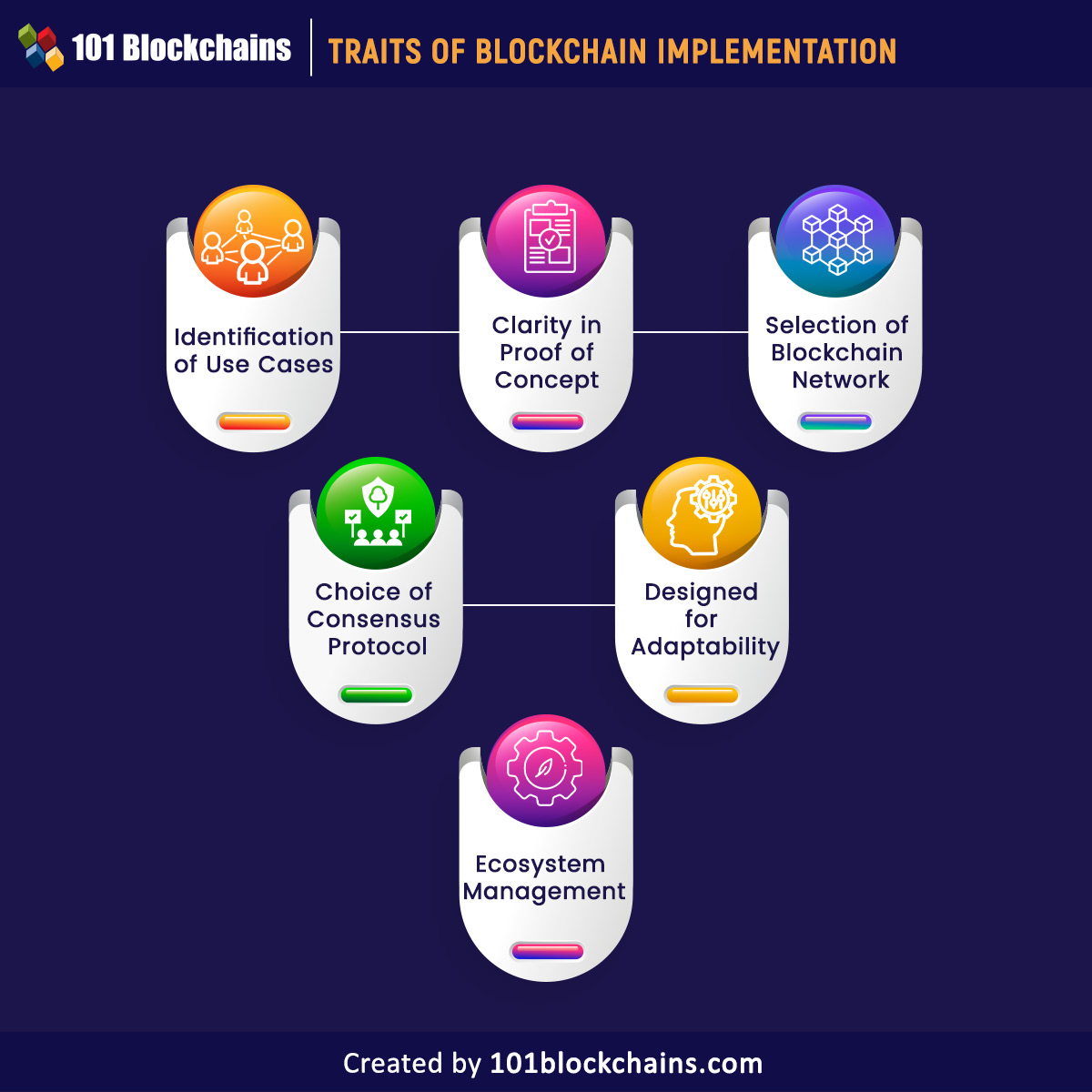Learn how blockchain truly works, master key definitions, and uncover what makes smart contracts so "smart." Dive into the fundamentals, gain valuable insights, and start your blockchain journey today!

- Blockchain
James Howell
- on October 31, 2022
Important Traits of a Successful Blockchain Implementation
Blockchain has introduced not only massive changes in the operations of digital currencies but also transformed many other sectors. The unique traits of blockchain, such as decentralization, immutability, security, and transparency, offer credible support for developing a new breed of applications. Interestingly, blockchain implementation factors with blockchain implementation steps and blockchain implementation examples also come into play in determining the chances of success for a blockchain project.
The attention to important factors over the course of implementing a blockchain solution would reflect profoundly in the final solution. As a matter of fact, you can identify the traits of a successful blockchain project directly from the stages of implementation. The following discussion will help you find out the important details of a successful blockchain project implementation. You can explore a detailed overview of what makes a blockchain implementation successful alongside some successful examples.
Curious to learn about blockchain implementation and strategy for managing your blockchain projects? Enroll Now in Blockchain Technology – Implementation And Strategy Course!
Why Should You Worry about Blockchain Implementation?
Blockchain is a new technology with a lot of power. Think of a superhero who discovered his/her powers recently and is trying to figure out how to use them. The tiniest miscalculation on the superhero’s behalf could end up in catastrophic consequences for people around them. Now, imagine blockchain as the source of unlimited power, which you can tap into to achieve many new advantages.
The lack of clarity regarding blockchain implementation steps could hold you back from achieving the true potential of blockchain in different use cases. As blockchain finds adoption across multiple fields, frequently evolving to cope with new user requirements, it is more important than ever to know the best practices for blockchain implementation.
The Bitcoin blockchain showed the possibility of peer-to-peer transactions to the world. Subsequently, Ethereum introduced smart contract programmability, thereby ensuring the development of many new applications, such as decentralized exchanges and lending platforms. With the unique benefits of transparency, cost-efficient operations, and seamless data sharing, blockchain applications can provide many prominent value-based benefits. All these reasons showcase the need to find how to implement blockchain in the best way to ensure that you can enjoy the benefits of blockchain.
Build your identity as a certified blockchain expert with 101 Blockchains’ Blockchain Certifications designed to provide enhanced career prospects.
Traits of Successful Blockchain Projects
The outcomes of every blockchain project vary on the basis of the intended use cases. On the other hand, every blockchain project follows a common set of practices for successful implementation. A closer overview of such practices can help you recognize the traits of successful blockchain implementation. Here are the crucial traits which can define a good blockchain project implementation.

-
Identification of Use Cases
The foremost question regarding blockchain implementation refers to whether it is blockchain expensive to implement as it creates formidable doubts. Blockchain is a new and revolutionary technology, thereby resulting in apprehensions regarding its implementation. Most users do not have a clear impression of the power of blockchain and its setbacks.
Therefore, it is important to perceive blockchain implementation as a long-term project and define specific use cases. A blockchain implementation project with clearly defined use cases would know where and how to proceed. What do you want to use blockchain for in a project?
A successful blockchain implementation example would focus on one or all of the essential use cases associated with blockchain. First of all, blockchain implementation must be secure with the applications of cryptography for managing access privileges. The blockchain should be shared and replicated, which means the seamless sharing of transactional data throughout the network, updated in the ledger of each node.
Blockchain implementation must also comply with use cases of immutability, implying the restrictions on modifying or deleting data after uploading on the blockchain. Most important of all, the blockchain implementation should also offer flexibility for the verification of transactions on the network.
-
Clarity in Proof of Concept
The next crucial highlight among blockchain implementation factors with blockchain implementation steps and blockchain implementation examples would refer to a Proof of Concept or POC. It is essential for verifying the real-life use of a blockchain application. The Proof of Concept helps in determining the feasibility of a blockchain project and its ability to accomplish the desired tasks.
With a clear Proof of Concept, the project can easily carry out the automation tasks and necessary processes for streamlining redundant tasks and actions of intermediaries. Blockchain Proof of Concept could also provide comprehensive insights regarding the value advantages for end-users in comparison to other technology solutions.
Many industries use blockchain technology to transform conventional routines in their daily operations. On top of it, they can rely on Proof of Concept to achieve the desired functionality. Some of the notable sectors which have embraced Proof of Concepts include telecom, fintech, management, insurance, KYC, and many others.
-
Selection of Blockchain Network
Any blockchain implementation would need a blockchain network for implementing the project. Generally, organizations assume that blockchain implementation steps refer to a blanket technology that you can use for implementing a solution. It is important to note that blockchain is not a universal technology. While it presents many value advantages, businesses can find the desired advantages only by selecting the ideal blockchain.
How can you define the choice of an ideal blockchain network for a specific blockchain implementation? You can check whether a blockchain network serves as the ideal choice for a specific implementation by reflecting on its abilities. Businesses can verify whether blockchain technology can cope with the intended challenges as compared to other alternatives. At the same time, ease of use and the facility of seamless integration with other applications also serves as the major determinant of feasibility in blockchain solutions.
Some of the popular blockchain networks you can consider for implementation include Ethereum, Hyperledger Fabric, Stellar, Open Chain, Corda, Quorum, and many others. As a matter of fact, the choice of a blockchain network could answer the “is blockchain expensive to implement” by accounting for the resources required and technical processes involved in each blockchain network. Businesses can also select the type of blockchain between public or private blockchain implementation, depending on their requirements.
Start your blockchain journey Now with the Enterprise Blockchains Fundamentals
-
Choice of Consensus Protocol
The next significant highlight of a successful blockchain implementation would refer to the ideal consensus protocol. You can work on blockchain implementation only through a valid consensus mechanism. The consensus mechanism is an essential ingredient for carrying out the calculations needed for verifying and adding transactions to the blockchain.
Most important of all, the consensus mechanism serves as a formidable safeguard against attempts at hacking and modification of blockchain data. Without the approval of a majority of participants in a blockchain network, it is impossible to add or change transactions in the blockchain.
Considering the power of consensus protocol, they are an important highlight in how to implement blockchain for desired use cases. Consensus protocols serve the outcome of better safety while establishing agreement among network participants regarding the network state. The effective and seamless distribution of information and updates throughout the holistic, distributed network proves the necessity of consensus protocols.
The common examples of consensus algorithms you can consider for blockchain implementation include Proof of Work, Proof of Stake, and Delegated Proof of Stake consensus algorithms. You can also find other interesting consensus protocols such as Proof of Staked Authority, Proof of Weight, or Byzantine Fault Tolerance consensus mechanisms.
Start learning Blockchain with World’s first Blockchain Skill Paths with quality resources tailored by industry experts Now!
-
Designed for Adaptability
The most noticeable highlight in a successful blockchain implementation steps and blockchain implementation examples would focus on the adaptability aspect. Blockchain implementations must have the capability to provide the necessary technology to resolve business issues. Therefore, blockchain implementations must work seamlessly with the existing processes in an organization.
At the same time, blockchain implementation must also have the flexibility to cope with uncertainty. If you find that a blockchain implementation struggles to achieve the desired requirements, then it requires revision. Such a type of evaluation can offer a firsthand impression of the effectiveness of blockchain implementation alongside improving the required groundwork.
The blockchain solution landscape is evolving, and new applications emerge with every passing day. At the same time, new regulations have been driving many formidable changes in implementations. Businesses cannot afford to skip compliance and must monitor blockchain implementations carefully to adapt to uncertain regulatory changes. Simultaneously, new technology advancements could also prompt uncertain precedents for blockchain implementations. Therefore, adaptability would be one of the key traits of successful blockchain implementation projects.
-
Ecosystem Management
The mention of blockchain automatically brings ‘decentralization’ to question, especially in terms of the design of the network. Now, it is important to ask whether all blockchain implementations are truly centralized. How decentralized is your blockchain implementation?
What are the mechanisms you have in place for ensuring governance of blockchain implementation? These questions draw your attention to one of the most important blockchain implementation factors, i.e., mechanisms for ecosystem management. The extent of decentralization in a blockchain implementation is evident in the flexibility and power it allocates to network participants.
Stakeholder management is a crucial determinant of success with blockchain implementations, and the approaches could vary considerably according to the use case. On the other hand, on-chain governance processes or DAOs are promising indicators of growth in blockchain implementations. A successful blockchain implementation not only aims to achieve desired operations for the short term but also focuses on empowering participants to decide the long-term picture.
Want to build your career in enterprise blockchains? Enroll Now in How to Build Your Career in Enterprise Blockchains Course!
Bottom Line
The highlights of blockchain implementation steps showed a brief glimpse into the best practices for implementing a blockchain project. Blockchain is a subject of mystery for many businesses which are interacting with blockchain for the first time. At the same time, the benchmarks for success with blockchain projects have frequently been changing with new improvements. However, you can identify the traits of successful blockchain implementation from the way the project is created.
A clear overview of the best practices for blockchain implementation showed the essential features of a successful blockchain project. Learn more about blockchain implementation strategy and the best practices for monitoring the effectiveness of your project before implementing it. Explore innovative learning resources on blockchain implementation and grow your expertise now.
*Disclaimer: The article should not be taken as, and is not intended to provide any investment advice. Claims made in this article do not constitute investment advice and should not be taken as such. 101 Blockchains shall not be responsible for any loss sustained by any person who relies on this article. Do your own research!






